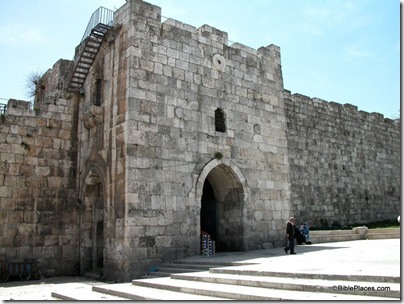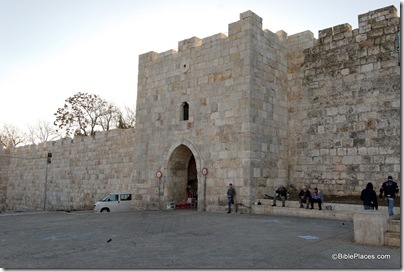Renovation work has been completed on Herod’s Gate (aka Flowers Gate) and a dedication ceremony is scheduled for June 28. From the Israel Antiquities Authority:
Herod’s Gate and sections of the walls adjacent to it were treated during the course of 2009 as part of the Jerusalem City Walls Conservation and Rehabilitation Project, which is funded by the Prime Minister’s Office, administered by the Jerusalem Development Authority and implemented by the Conservation Department of the Israel Antiquities Authority. The rehabilitation work on the gate took four months to complete and was conducted in cooperation with the local residents and merchants so as not to disrupt the bustling urban activity that is characteristic of the place.
The conservation and rehabilitation measures to the gate were preceded by very strict preparations that included a meticulous conservation and historical survey and documentation of the gate. During the course of the conservation work there the IAA Conservation Department had to contend with the complicated challenge of working in a teeming urban and commercial environment. The gate’s facades and interior received extensive treatment that included a thorough cleaning, treating the stones and decorations that have been subjected to years of weathering and removing hazards that stemmed from vegetation taking root and vandalism, as well as moisture penetrating into the fabric of the city wall. Among other actions that were taken, all of the electrical and water infrastructures that “adorned” the gate’s facades were removed and properly reinstalled so as not to detract from the appearance of the gate.
The Old City walls were built in the sixteenth century by the sultan Suleiman the Magnificent. Within the framework of that project Herod’s Gate was first inaugurated in the year 1539 CE. The gate was constructed originally as a postern gate which only allowed people and unharnessed animals to enter the city. At the end of the nineteenth century an opening was breached in the gate’s northern façade which allowed passage directly into the city. Remains of the sentry post that protected the original entrance can still be seen in the gate’s eastern façade.
The full press release is here (temporary link), along with a link to a zip file with five photographs showing the exterior and interior of the gatehouse, before and after restoration.

